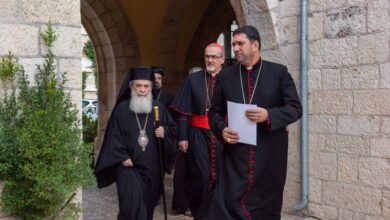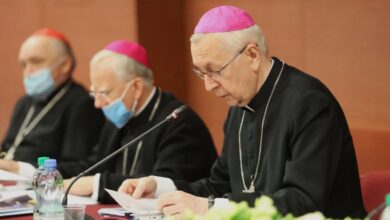‘Little miracle of Lille’: How a candlelight Mass gathers hundreds of young people every week in France

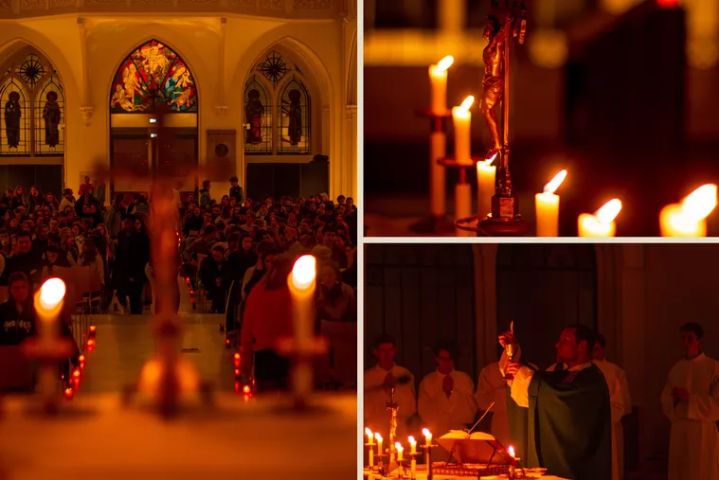 Every Tuesday evening at 10 p.m., between 800 and 900 students converge on the historic St. Joseph’s Chapel at Lille Catholic University for a candlelight Mass. / Credit: Courtesy of Prudence Cuypers
Every Tuesday evening at 10 p.m., between 800 and 900 students converge on the historic St. Joseph’s Chapel at Lille Catholic University for a candlelight Mass. / Credit: Courtesy of Prudence Cuypers National Catholic Register, Apr 27, 2024 / 06:00 am (CNA).
“The good makes no noise,” St. Francis de Sales would say of Lille’s candlelight Mass.
Indeed, while France regularly shows itself to be at the forefront of the de-Christianization of the West and recently made headlines for its constitutionalization of abortion, the embers of Christian renewal are already igniting — quietly yet powerfully — on the country’s northern horizon.
Every Tuesday evening at 10 p.m., between 800 and 900 students converge on the historic St. Joseph’s Chapel at Lille Catholic University for a candlelight Mass. This number has been growing month after month since the initiative was launched in 2016 and has significantly increased the number of new catechumens there journeying toward baptism.
For its initiators, this unexpectedly successful formula is a universal model to be exported to touch the souls of the vast number of young people who thirst for interiority in a world profoundly atomized by the expansion of the virtual world into all spheres of daily life.
‘Simplicity of beauty’
Launched on the initiative of a group of six students in a small chapel under the chaplaincy of the prestigious Lille university (France’s largest private not-for-profit university, also known as “La Catho”), the candlelight Mass quickly surpassed the 300-participant mark, forcing the organizers to relocate in order to continue to welcome the growing flow of students, whether believers or simply curious.
To this end, in 2019, the large St. Joseph’s Chapel adjoining the school, which celebrated its 100th anniversary this year and was long used as a room for students to take exams, was restored. The following year, the building’s capacity of some 600 seats was met at the Mass, forcing students to arrive early to avoid standing or sitting on the floor.
During Lent this year, the security service had to turn away hundreds of faithful, as current regulations forbid the reception of more than 900 people in the building.
How to explain the craze for a Mass in the middle of the week when Europe’s churches are tending to empty out at a worrying rate?
While traditionalist and charismatic movements within the Church have had a rare ability to galvanize crowds in France in recent years, as demonstrated by the incredible success of pilgrimages to Chartres and Paray-le-Monial, this Mass in Lille makes no claim to any particular identity or sensibility, other than an attachment to the beauty of the liturgy and the quality of its preachers. The chants are usually sung by a polyphonic choir, whose depth and musicality the participants praise.
“Over and above the various movements developing within the Church today, I think that what is most likely to attract young people is the simplicity of beauty,” said Joséphine Auberger, a student at La Catho and head of communications at the chaplaincy.
She added: “I have a friend who usually only attends the Traditional Latin Mass, precisely because of his quest for beauty, and who finds himself completely in this celebration, and I think he’s far from alone.”
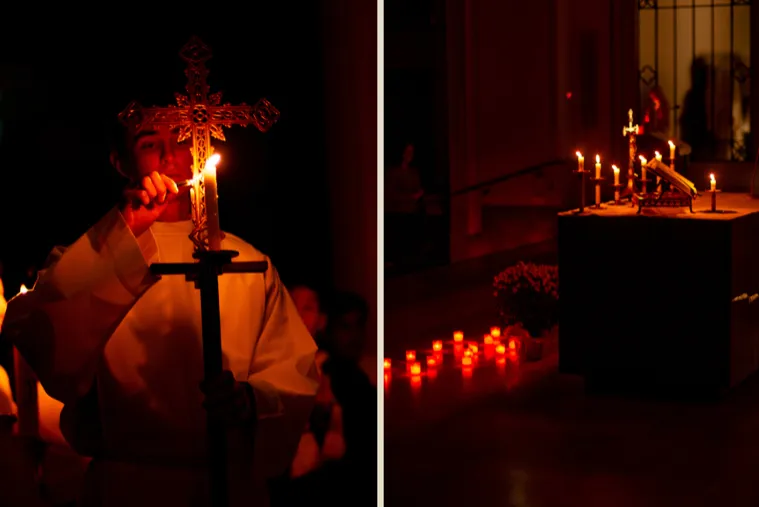
For Louis Tranié, a physiotherapy student and vice president of the chaplaincy office, the “WYD Lisbon” effect (referring to the World Youth Day that attracted hundreds of thousands of pilgrims to the Portuguese capital in August 2023) has also added to the fervor surrounding this weekly gathering.
“People attract people; word of mouth has played a big part in this unexpected triumph, not to mention the fact that immersion in the dark also attracts many young people estranged from the Church, who are thus no longer afraid of being judged by their neighbors,” Tranié noted.
“The time — 10 p.m. — also represents free time for these students, who have finished their day and generally have nothing planned for that time,” evoking an ideal moment to “give something to God and receive something in return,” added Father Charles-Marie Rigail, chaplain at the Catholic university.
Anchor in a changing world
Placed mainly in the choir and central aisle, so that only Christ on the crucifix is illuminated, the candles are there to help the young participants raise their gaze to heaven in an authentic heart-to-heart with God, stripped of all worldly artifice.
“Everything is focused on the Word of God, of his Church, which goes so much further than what men are capable of creating, and which is part of a long history and tradition that goes back a long way, offering a solid anchor for all those who are thinking about their future and feel they are living in a very changeable world, very liquid and filled with uncertainties,” Rigail said.
He added with a smile that the world’s Instagram and other social networks, on which young people spend a lot of their time, will never be able to quench this thirst to belong to something beyond fashions and ephemeral electronic devices.
“This is how to touch people’s hearts, break down current prejudices about the Church, and raise awareness of its usefulness and relevance, trying to offer something that is good and as right as possible.”
The young chaplain also pointed out that, alongside the community dimension instilled by the crowd, this darkness penetrated by candlelight alone makes for a very personal experience, a necessary condition for the interiority that this Mass aims to foster.
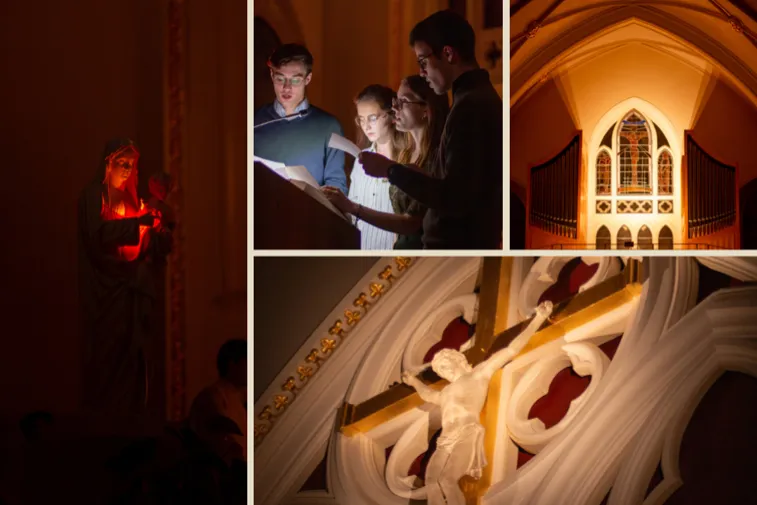
Creating torchbearers
Apart from the triumph of the initiative, revealed by figures directly at odds with the general trend in the country, other fruits are already visible, made manifest by the doubling of new catechumens every year for the past four years.
“I make it a point to stay and chat with people after Mass, and I meet all kinds of people, from classic practicing Catholics to avowed atheists, some of whom, moved by what they saw, end up wanting to know more, while some nonpracticing believers decide to go further in their faith,” Rigail said.
This evangelizing mission is reinforced throughout the rest of the week by the various activities promoted by the eight young members of the chaplaincy office and the many volunteers who assist them.
The ultimate mission of this initiative, as Rigail recalled, is in fact not to turn those who approach it into “consumers of beautiful liturgy” but rather into Catholics capable of being actors of their own faith and exporting this model once they’ve left university.
“We’d be missing the point if, on arriving in their local parishes, these young people were discouraged by far less engaging celebrations and decided to travel 50 kilometers to find a liturgy that suited them,” he concluded. “On the contrary, our aim is to increase their appreciation of the liturgy to the point of encouraging them to roll up their sleeves and get more involved in their parishes to enhance the beauty of the celebrations and thus reproduce locally the ‘little miracle of Lille.’”
This story was first published by the National Catholic Register, CNA’s sister news partner, and is reprinted here on CNA with permission.



